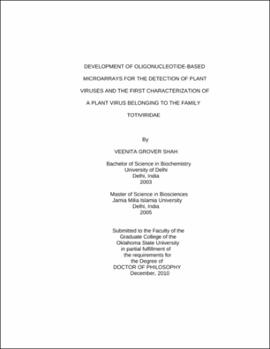| dc.contributor.advisor | Melcher, Ulrich | |
| dc.contributor.author | Grover Shah, Veenita | |
| dc.date.accessioned | 2013-11-26T08:22:52Z | |
| dc.date.available | 2013-11-26T08:22:52Z | |
| dc.date.issued | 2010-12 | |
| dc.identifier.uri | https://hdl.handle.net/11244/6645 | |
| dc.description.abstract | Scope and Method of Study: Ongoing studies for discovery of viral species in non-cultivated plants utilize several genomic approaches for systematic unbiased searches for viruses related to known viruses. Some of these approaches and their suitability for investigations of viruses in wild plants are summarized here. These methods include particularly array hybridization to macroarrays and microarrays, and various megasequencing approaches. A part of this thesis work was aimed at developing a microarray based on a sequence-independent amplification method with the potential to detect a broad group of plant viruses including detection of new virus species, strains and variants. The other part of the work was to investigate a putative virus belonging to the family Totiviridae, discovered from the wild plant population of Tallgrass Prairie Preserve of Oklahoma and designated here as Ruellia asymptomatic virus 1. This study addressed two main questions. First, whether the putative virus is a mycovirus of a fungal endophyte that is colonizing the host plants or a plant virus or a virus that is transmitting between plants and fungi. Second, if the virus is a plant virus, is it possibly a persistent plant virus. | |
| dc.description.abstract | Findings and Conclusions: The microarray method developed and described in this study demonstrates a viable procedure for nucleic acid amplification and hybridization that should be effective in detecting most plant RNA or DNA viruses as long as the virus has some representative sequence information available. The system was validated in pure and mixed samples by detection of three Tymovirus species: Asclepias asymptomatic virus, Kennedya yellow mosaic virus and Turnip yellow mosaic virus. The method could detect sequence variants with 70-75% or higher sequence identity, indicating the possible utility of the approach for virus discovery. From the second part of the work, we show evidence for the first putative plant virus in the family Totiviridae. Using in situ hybridization, the viral RNA was observed to localize inside the cells of virus-infected plant stem sections, suggesting its identification as a plant virus. Seed transmission analysis performed on the progenies of the virus-infected plants demonstrated vertical transmission of the virus, and hence persistence of virus in its host plants. In conclusion, investigation of viruses in the wild plant population can serve as a launching point for additional studies focused on demonstrating disease causality, and dissecting the possible mutualistic roles of plant viruses in natural settings. | |
| dc.format | application/pdf | |
| dc.language | en_US | |
| dc.rights | Copyright is held by the author who has granted the Oklahoma State University Library the non-exclusive right to share this material in its institutional repository. Contact Digital Library Services at lib-dls@okstate.edu or 405-744-9161 for the permission policy on the use, reproduction or distribution of this material. | |
| dc.title | Development of oligonucleotide-based microarrays for the detection of plant viruses and the first characterization of a plant virus belonging to the family Totiviridae | |
| dc.contributor.committeeMember | Roossinck, Marilyn J. | |
| dc.contributor.committeeMember | Palmer, M. W. | |
| dc.contributor.committeeMember | Hoyt, Peter R. | |
| dc.contributor.committeeMember | Ayoubi-Canaan, Patricia | |
| osu.filename | Grover_okstate_0664D_11129 | |
| osu.accesstype | Open Access | |
| dc.type.genre | Dissertation | |
| dc.type.material | Text | |
| dc.subject.keywords | in situ hybridization | |
| dc.subject.keywords | microarrays | |
| dc.subject.keywords | persistent virus | |
| dc.subject.keywords | plant virus detection | |
| dc.subject.keywords | plant virus in the family totivirida | |
| thesis.degree.discipline | Biochemistry and Molecular Biology | |
| thesis.degree.grantor | Oklahoma State University | |
